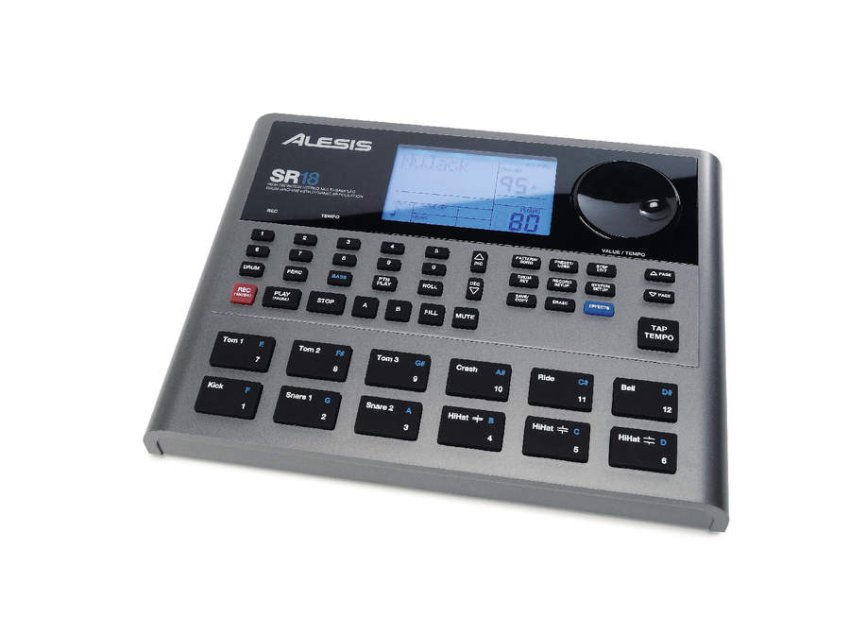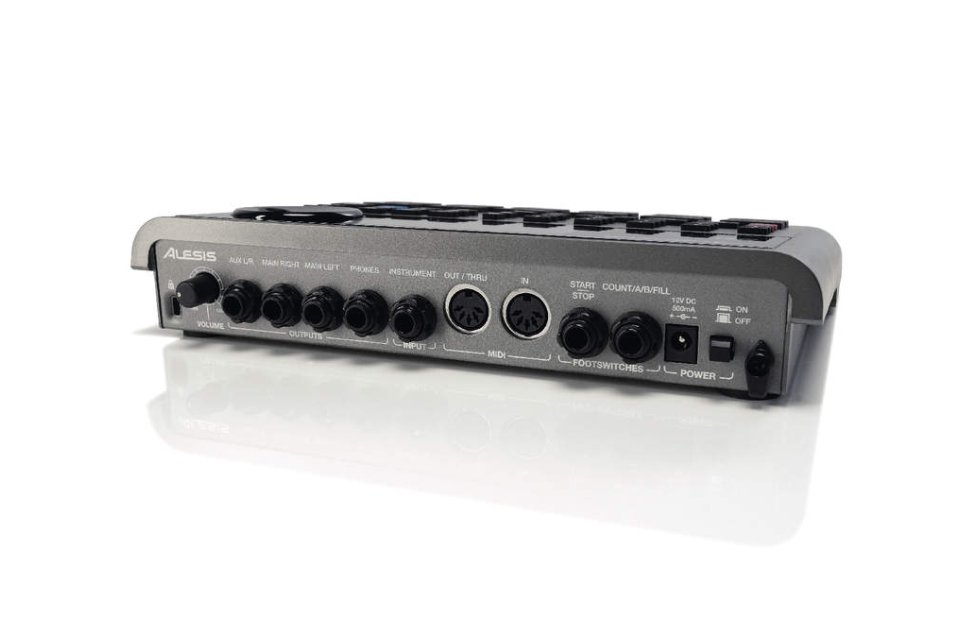MusicRadar Verdict
The SR18 won´t start a revolution, but it does live up to its predecessor´s good name.
Pros
- +
Impressive sample list. Percussion and bass kits. Rugged construction.
Cons
- -
Instrument input is flawed.
MusicRadar's got your back

Alesis SR18

Alesis SR18
Since the Alesis SR16 came out in the early '90s, technology has set some serious challenges for the humble drum machine. Though there is a market for 'retro' (ie, before 2000) drum machines, one might be sceptical about the relevance of a non-sampling hardware drum box in this day and age.
Alesis isn't, though, for it's updated the stalwart SR16, doubling the number of sound samples and preset slots, adding an instrument input and implementing 24-bit resolution on the output.
Overview
After a quick perusal it becomes clear that the SR18 is ostensibly the same as its ancestor. Space is at a premium at the rear of the module, so to fit the new instrument input in, the two Aux output jacks have been shrunk down to a TRS stereo jack.
Though the main outputs are unbalanced, a stereo jack is not a great option, necessitating a splitter (or a bit of soldering) for connection to most equipment.
The usual suspects are also found lurking around the back: MIDI In/Out/Thru, two footswitch inputs (for start/stop and fill/pattern toggling), volume knob, headphone jack and power switch with DC input
On top, the rubbery knobs are pleasingly tactile yet durable and the LCD is now well lit and substantial enough to make it visible from a distance. The casing may be plastic, but the SR18 feels weighty and rugged enough to endure a long term beating.
If you've ever used a drum machine before, most of the controls here will be familiar: Step Edit, Roll, Fill, Tap Tempo, etc. Creating, editing and arranging patterns is simple, though step editing is still a bit of a battle compared with modern programming methods.
There are plenty of preset rhythms on offer, which range from the surprisingly good to the frankly cheesy (you know you wanna boss nova!). What is impressive, though, is the sheer number of drum kits that are ready and waiting for you to bash around.
Sounds
The sounds are generally of a good quality, free from any nasty digital noise artefacts, and the range of tones is definitely an improvement on previous models. The standard pitch and envelope controls enable you to tailor the hits just enough, but there aren't so many options that you get lost spending hours just programming the snare drum.
Acoustic drum samples in drum machines are often a bit ropey, but there are some very useable sounds here, especially on the percussion side. That said, the velocity-varied acoustic drums (especially the snares) still lack the ability to roll convincingly.
The non-real-world drum sample collection covers all the classics as well as many handy hits and effects for a whole host of genres, but it's when you discover the addition of percussion and bass samples/patterns that the most significant changes become apparent.
While the original SR16 allowed only one drum kit to be programmed, the SR18 has been expanded to feature a percussion kit and bass instrument. These additional two kits can be programmed in the same way as the drums, with the percussion utilising 102 root sounds and the bass offering 50 different basic instruments.
The percussion sounds are highly usable, adding some groove to the drum patterns. The bass is not going to put dedicated synths out of work, but as a quick performance and writing tool it does a fine job.
Sound processing, beyond the pitch, filter and envelope controls for each hit, comes in the form of 22 reverb presets (with a global send level) and 14 EQ/compression presets. These processors aren't going to make your jaw drop, but they are adequate and enable you to give the overall tone a bit of shape and space.
The aforementioned instrument input is an attractive feature for those guitarists/bassists who want to practice their chops or work out a quick demo. The downside is that there is no gain adjustment (or output assignment), and even a relatively low output guitar can overpower the drums and percussion level, with an active preamp bass causing heavy distortion unless the instrument's volume knob is brought right down.
Summary
So, who - if anyone - is going to buy the SR18? Well, there will be some who have driven their '90s rhythmic pit-pony into the ground and just want a replacement. The addition of percussion and bass instruments expands the programming range of the unit, and the 571 sounds, 175 preset rhythm patterns, 100 drum kits and 50 different bass sounds is impressive, yet not too overwhelming.
The SR18 is a considered update to its predecessor; Alesis hasn't gone overboard, so it remains a simple and effective tool. There's not too much to criticise, though we're not totally convinced that the addition of the instrument input is worth the removal of an output jack.
However, this is a quick and easy box that's far less likely to break than a laptop. And unlike the SR16, it's battery operable and has a display that you can see when the stage lights drop.
Listen to the SR18 in action:
“Built from the same sacred stash of NOS silicon transistors and germanium diodes, giving it the soul – and snarl – of the original”: An octave-fuzz cult classic returns as Jam Pedals resurrects the Octaurus
What’s the buzz? Meet Yellowjacket, Cherry Audio's recreation of EDP’s trend-setting Wasp from 1978
“A fabulous trip through all eight songs by 24 wonderful artists and remixers... way beyond anything I could have hoped for”: Robert Smith announces new Cure remix album









